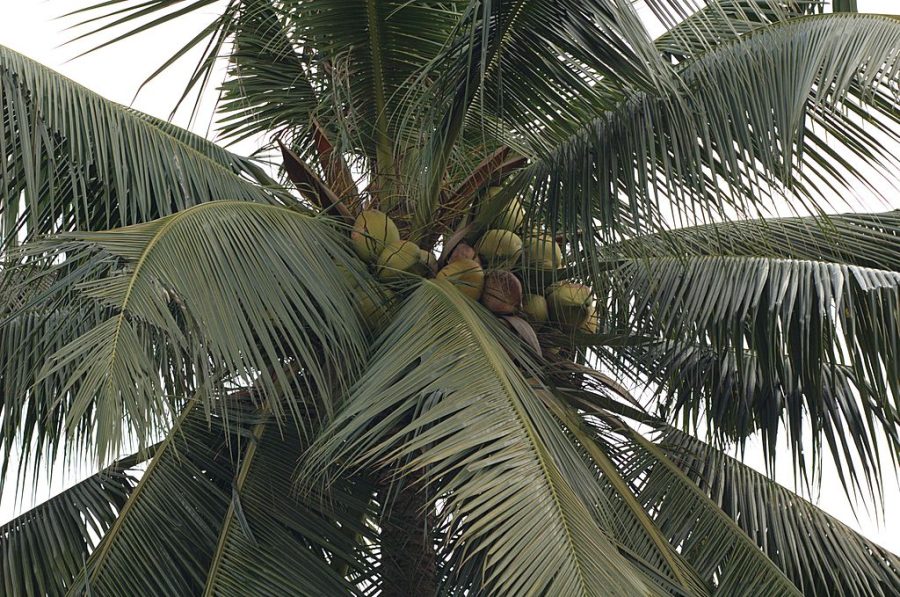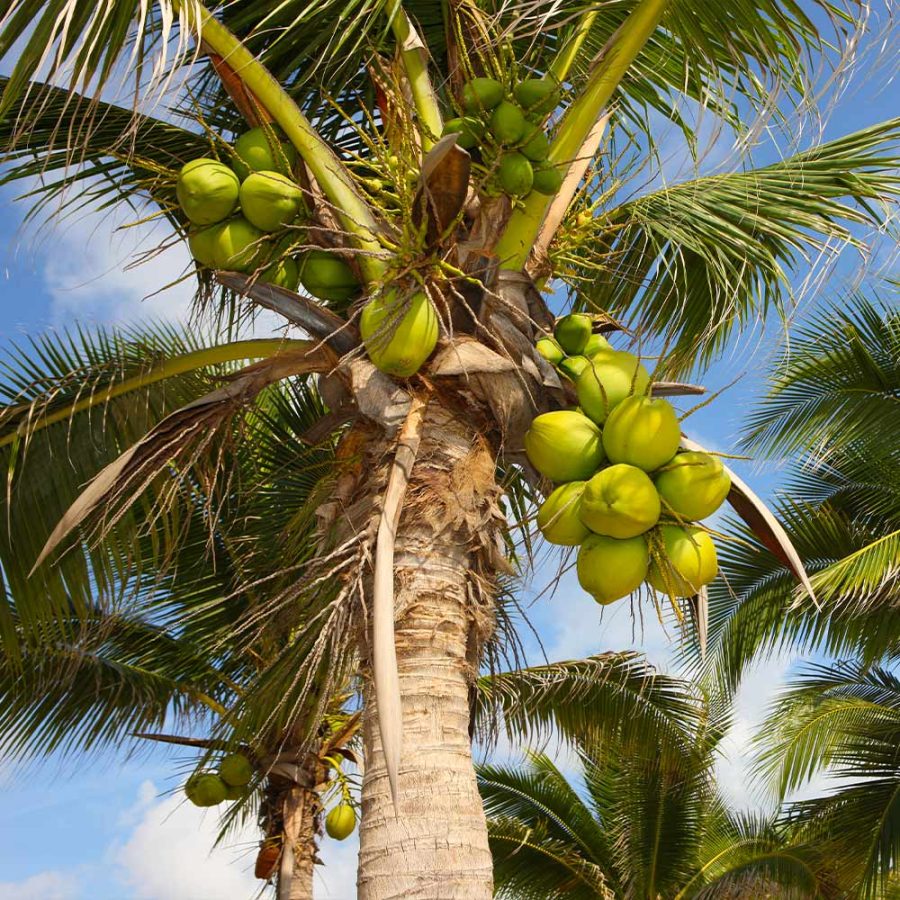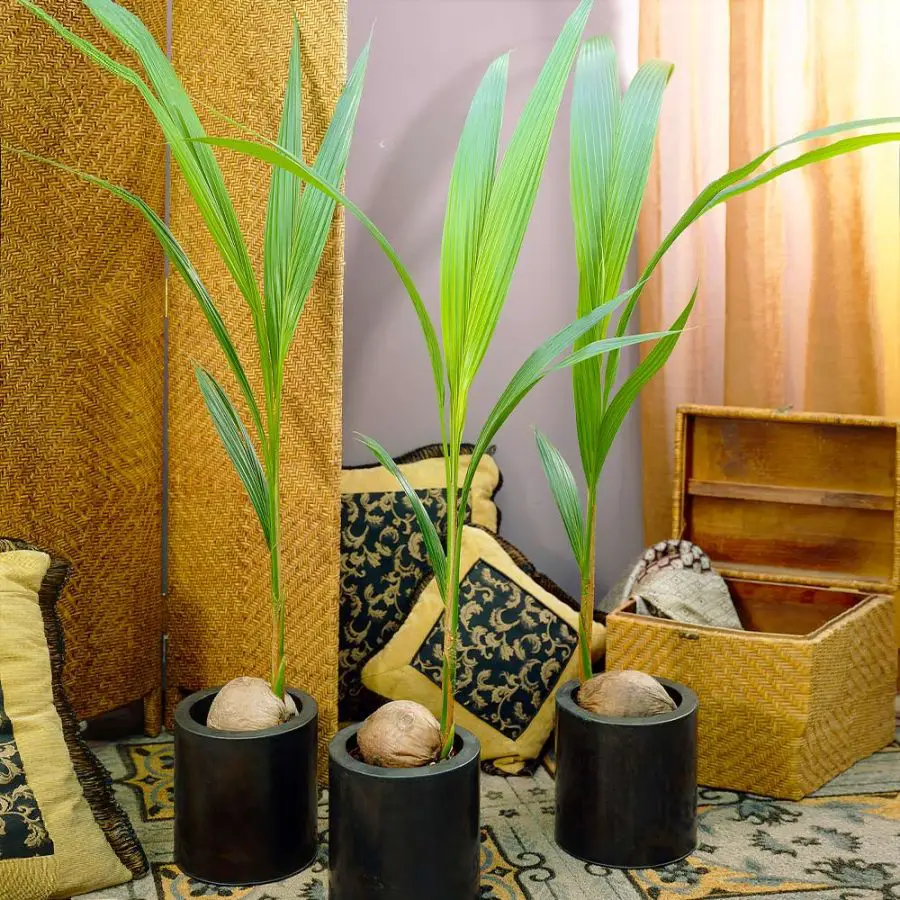This post contains affiliate links. If you buy something from one of our links we may earn a commission. Thanks

Bring a tropical paradise indoors! Learn how to grow coconut palms in containers and enjoy fresh coconuts right in your home. Our easy guide will show you how.
Growing Coconut palms in containers indoors is a feasible endeavor with the right approach. Opt for a dwarf variety like the Cocos nucifera ‘Green Malayan’, use a large, well-draining container, and a soil mix of coco coir and perlite.
Ensure your palm gets at least 6 hours of sunlight, regular watering without waterlogging, and monthly fertilization during the growing season.
With patience and proper care, you can enjoy a tropical ambiance right in your home, although fruiting is less likely.
Looking to add a touch of the tropics to your home or garden? Consider growing coconut trees in containers!
With the right care and conditions, you can even grow coconut palms indoors and enjoy this as an ornamental plant that might even give you fresh coconuts.
In this guide, we’ll show you everything you need to know to get started.
Coconut Palm Tree Quick Stats
Mature Height: 5-10 ft Indoors 20-40 ft Outdoors
Mature Width: 5-10 ft Indoors10-15 ft Outdoors
Sunlight: Full-Partial
Growth Rate: Moderate
Botanical Name: Cocos nucifera ‘Green Malayan’
Grows Well In Zones: 4-9 patio / 10-11 outdoors
Get your Cocos nucifera ‘Green Malayan’ dwarf coconut tree here
Why Grow Coconut Palm Trees?
Coconut Palm Trees has become one of the most popular types of trees in the world due to their large and delicious coconuts and attractive foliage.
One of the best parts about Coconut Palms is that they can be grown indoors in containers, making it possible for anyone to grow their own coconuts regardless of their location.
You can move the container outside on warm, sunny days, and bring it back indoors during the colder months.
With a little patience, you can enjoy coconuts from your very own tree.
The unique tropical look of the Coconut Palm is achieved as it grows out of a coconut that sits in its container and eventually matures into a beautiful palm with gray-barked rings and a large crown filled with fronds of bright green pinnate leaves.
The coconut tree (Cocos nucifera) is a member of the palm tree family (Arecaceae) and the only living species of the genus Cocos. The term “coconut” (or the archaic “cocoanut”) can refer to the whole coconut palm, the seed, or the fruit, which botanically is a drupe, not a nut…They are ubiquitous in coastal tropical regions and are a cultural icon of the tropics.
https://en.wikipedia.org/wiki/Coconut

Coconut Palms are low-maintenance and have a high heat and drought tolerance, making them perfect for indoor growing.
Whether it’s inside your home, on your porch, or patio, Coconut Palms will fit perfectly, creating a beautiful and tropical atmosphere in any space.
Growing Coconut Trees in Containers
Brief Overview of Growing Coconut Trees in Containers
If you’re looking to add a touch of the tropics to your home or garden, growing coconut trees in containers is an excellent way to do so.
By planting and nurturing a coconut tree in a container, you can enjoy the benefits of having your very own mini tropical paradise, no matter where you live.
Advantages of Growing Coconut Trees in Containers
There are many advantages to growing coconut palm trees in containers, including:
Space-saving: With a container, you can grow a coconut tree even if you have limited outdoor space.
Portability: Containers allow you to move your coconut tree around as needed to maximize sunlight and other environmental conditions.
Fresh coconuts: By growing your own coconut tree, you can enjoy the taste of fresh coconuts right from your own garden or living room.
Easy care: With the right container, soil, and care, coconut trees are relatively low-maintenance and can thrive in a container.
Can You Grow a Coconut Tree from a Store-Bought Coconut?
Yes, you can grow a coconut tree from a store-bought coconut, but it’s important to choose the right type of coconut and follow the proper steps for germination.
Here’s how to go about planting coconuts:
• Choose a ripe coconut with a hard, brown shell and shake it to ensure there’s coconut milk inside.
• Soak the coconut in water for a day or two to soften the outer shell.
• Plant the entire coconut in a container with well-draining soil, burying it with about one-third of the coconut above the soil.
• Water the coconut regularly, keeping the soil moist but not waterlogged.
By following these steps, you can successfully grow your own coconut tree from a store-bought coconut. This is a long-term project as it can take 4-6 months for a coconut to sprout.
Buy A Dwarf Coconut Palm

A much better option is to buy a coconut palm tree, It may cost more but you won’t have to wait 6 months to start enjoying it.
We offer Cocos nucifera ‘Green Malayan’ which produces dwarf coconut trees.
If you really want to grow coconuts in a container we recommend the best way is growing dwarf varieties. They are easier to keep indoors.
They also will bear earlier and give you a much better chance of actually getting coconut fruit.
In the next part of this guide, we’ll go over how to choose the right container for your coconut tree, the best soil mix, and how to plant the tree.
I heard you probably won’t get coconuts and the tree will only live about 5 years in a container. Is this true?
Yes, it is true that growing coconut trees in containers may not result in the tree producing coconuts.
This is because standard coconut trees need a lot of space to grow and thrive, as well as specific environmental conditions like high humidity, warm temperatures, and bright sunlight.
Additionally, while coconut trees can live for decades in their natural habitat, they may have a shorter lifespan when grown in a container.
This is because the roots may become constrained and the tree may not have access to enough nutrients to sustain its growth over a long period of time.
This is why we recommend buying a dwarf coconut variety.
However, with proper care and attention, it is still possible to enjoy the beauty and tropical vibes of a coconut tree in a container.
Just keep in mind that the tree may have a limited lifespan and may not produce coconuts.
If your goal is to harvest fresh coconuts, consider our dwarf Cocos nucifera ‘Green Malayan’ it may be the best to plant indoors.
Otherwise, you need a larger outdoor space where it can grow to its full potential assuming you live in the right climate for it to grow outdoors. (South Florida)
Choosing the Right Container
Welcome back to our guide on growing coconut trees in containers!
In the previous section, we discussed the basics of growing a coconut tree from a store-bought coconut.
Now, let’s dive into the next step: choosing the right container for your tree.
The container you choose can play a crucial role in the success of your coconut tree, as it will determine the amount of space the roots have to grow, the moisture retention of the soil, and the overall health of the tree.
In this section, we’ll go over everything you need to know to choose the best container for your coconut tree and ensure its long-term health and growth.
Size and Shape of the Container
When choosing a container for your coconut tree, it’s important to consider the size and shape of the container.
Coconut trees require a lot of space to grow and thrive, so it’s best to choose a large pot that is at least 24 inches in diameter and 20 inches deep.
The shape of the container is also important, as coconut tree roots grow downward and need enough space to do so.
A tall and narrow container may not provide enough space for the roots to spread out, while a wide and shallow container may not hold enough soil or water.
Materials of the Container
The materials of the container are also an important consideration.
Coconut trees prefer porous materials like terra cotta or clay pots, as they allow air and water to circulate around the roots.
These materials also absorb excess moisture, which can help prevent root rot.
Although plastic containers can work they are not recommended for coconut planters, as they may trap moisture and heat and can lead to root rot or other issues.
Drainage Requirements
Finally, it’s crucial to consider the drainage requirements of your container. Coconut trees need well-draining soil and can be sensitive to standing water.
Make sure your container has drainage holes in the bottom to allow excess water to escape.
You can also add a layer of rocks or gravel to the bottom of the container to help improve drainage.
If you’re using a porous container like terra cotta, it’s a good idea to soak it in water for a few hours before planting to prevent it from absorbing too much moisture from the soil.
Choosing the Right Soil
Hello again, coconut tree enthusiasts! In our last section, we covered the importance of choosing the right container for your coconut tree.
Now that you have your container picked out, it’s time to think about the soil. The type of soil you choose can have a significant impact on the growth and health of your coconut tree.
In this section, we’ll go over the key factors to consider when selecting soil for your container-grown coconut tree.
We’ll discuss the ideal pH levels, nutrients, and other important considerations to ensure your tree has everything it needs to thrive.
So, let’s dive in and learn how to choose the right soil for your coconut tree!
Soil Requirements for Coconut Trees
Coconut trees need well-draining soil with good water retention to thrive. They prefer slightly acidic soil with a pH range of 5.0 to 8.0.
The soil should also be rich in nutrients, including nitrogen, phosphorus, and potassium.
When growing coconut trees in containers indoors, it’s important to choose a soil mix that will meet these requirements.
Why Coco Coir and Perlite is Better than a Peat-based Soil Mix
Coco coir and perlite is a better soil mix option for coconut trees than a peat-based soil mix for a few reasons.
First, peat-based soil mixes tend to be too dense and can retain too much water, which can lead to root rot.
Coco coir and perlite are much lighter and allow for better aeration and drainage, which is crucial for the health of your coconut tree.
Additionally, coco coir and perlite are a more sustainable option, as they are made from renewable resources and do not harm natural peat bogs.
Preparing the Soil Mix
To prepare the soil mix for your container-grown coconut tree, start by combining coco coir and perlite in a 50/50 ratio.
You can try different mixes from 25 to 33% perlite. The more perlite used the better the drainage but it also means you will need to water more frequently.
Mix them thoroughly to ensure even distribution. You can also add a slow-release fertilizer to the soil mix to provide the necessary nutrients for your tree.
Coconut trees are heavy feeders, so it’s important to ensure they have access to the nutrients they need to grow strong and healthy.
While potting soil may contain nutrients coco coir does not. It is solely a growing medium and needs to be fertilized.
Planting the Coconut Palm Tree

Hello again, fellow coconut tree enthusiasts! In the previous sections, we’ve covered the importance of choosing the right container, soil, and environment for growing coconut trees indoors.
Now, it’s time to dive into the exciting part – planting your very own coconut tree!
In this section, we’ll walk you through the steps to plant your coconut tree and give you some tips to help ensure a successful and healthy start for your tree.
So, let’s roll up our sleeves and get ready to plant our coconut tree!
Preparing the Container for Planting
Before planting your coconut tree, it’s important to prepare the container properly. Start by filling the container with the soil mix you prepared in the previous section, leaving about 2-3 inches of space at the top.
Ensure that the soil is evenly distributed and that there are no air pockets in the container. Gently pat down the soil to make it firm and level and water it.
Planting the Coconut Tree
Once the container is ready, it’s time to plant your coconut tree. Some people recommend planting it with the pointy side down.
I think it’s best to lay it sideways. Take your coconut and place it on top of the soil. Bury the bottom two-thirds of the coconut in the soil, leaving the top one-third exposed.
If you have a sprouted coconut be gentle when planting the coconut to avoid damaging the roots or sprout.
It’s best to plant one coconut per container, as they need plenty of room to grow.
Watering the Coconut Tree
After planting, give the coconut tree a good watering. Water until the soil is evenly moist but not waterlogged.
Coconut trees need regular watering, but be careful not to overwater them. Overwatering can lead to root rot and can be fatal to your tree.
A good rule of thumb is to water your coconut tree when the top inch of soil feels dry to the touch.
As your tree grows, you may need to increase the frequency of watering.
And that’s it! With the right container, soil mix, and watering, you’ll be well on your way to growing a healthy and thriving coconut tree indoors.
Planting A Coconut Palm Tree
While growing a coconut tree from a sprouted coconut is a fun project, you may also want to try your hand at planting an actual coconut palm tree.
This can be quite a bit less challenging and you will not have to wait months to see results.
To plant a coconut palm tree, you’ll need to find a suitable location that gets plenty of full sun and has well-draining soil.
Choose a container that is at least 2-3 inches larger than the size of the root ball of the palm.
A container that is too small will restrict the root growth, and the plant may not thrive.
Make sure that the container has drainage holes to allow excess water to escape.
How To Plant Coconut Trees In Containers
• Fill the container about 1/3 full with well-draining soil. Use a high-quality potting mix that is specifically formulated for palms. Or use your coco coir perlite mix.
• Hold the plant in place and backfill around the root ball with soil, ensuring that the plant is positioned upright. Gently press down the soil around the base of the plant to firm it in place.
• Water the plant thoroughly to settle the soil around the roots. Keep the soil evenly moist but not waterlogged. Do not let the soil dry out completely.
• Place the container in a sunny location with plenty of natural light and in a warm area.
• They don’t grow well in cooler climates either in or outdoors. They grow in tropical climates so find them a warm spot to grow them.
• Coconut palms require at least 6 hours of direct sunlight daily. You can also use artificial lights to supplement the natural light.
• Coconut palms need to grow in a temperate climate and can be injured by cold weather and may be killed by temperatures below 32 degrees Fahrenheit (0°C) and can show symptoms of chilling injury at temperatures as high as 40°degrees F (5°C).
• Fertilize the coconut palm every 3-4 weeks with a slow-release palm fertilizer. Follow the instructions on the label for the recommended amount of fertilizer to use.
• With proper care and maintenance, your coconut palm can grow to be a beautiful and impressive indoor plant.
Caring for the Coconut Tree
Congratulations on successfully planting your very own coconut tree in a pot!
Now that your tree is growing, it’s important to know how to care for it properly to ensure it stays healthy and continues to thrive.
In this section, we will discuss the necessary care and maintenance for your coconut tree while it grows indoors.
With a little effort and attention, you can enjoy a beautiful and healthy coconut tree right in the comfort of your own home.
Watering the coconut tree:
Coconut trees need to be watered regularly to keep the soil evenly moist. Your soil needs to provide the right conditions for them.
They are used to growing in moist soil. It also must be well-drained soil. Do not let the soil dry out completely or become waterlogged, as either can harm the plant.
Water the plant deeply, and then allow the soil to dry out slightly before watering again.
Make sure the container drains well and empty any standing water in the saucer.
The frequency of watering depends on the size of the container, the soil type, and the environmental conditions.
In general, you may need to water the coconut palm once or twice a week.
Fertilizing the coconut tree:
Coconut palms need regular fertilization to grow and thrive. Use a balanced liquid complete fertilizer that contains trace nutrients.
Fertilize the plant every month during the growing season (spring and summer).
Basic nutrients may not contain all the micronutrients these palms need to stay healthy so make sure to use a complete fertilizer.
Follow the instructions on the label for the recommended amount of fertilizer to use. Do not fertilize the plant during the dormant season (fall and winter months).
Pruning the coconut tree:
Coconut palms do not require extensive pruning, but it is still important to remove any dead or damaged leaves regularly.
Use sharp, clean pruning shears to snip off any brown or yellowing fronds close to the trunk.
Do not remove green fronds, as they are still producing energy for the plant.
Protecting the coconut tree from pests and diseases:
Coconut palms are generally resistant to pests and diseases, but they can still be affected by some common issues.
Keep an eye out for spider mites, scale insects, or mealybugs, and treat them with insecticidal soap or neem oil as soon as you spot them.
Make sure to keep the area around the plant clean and free of debris, which can harbor pests and diseases.
In addition, ensure that the plant is getting enough light and air circulation to prevent any fungal or bacterial growth.
Harvesting Coconuts

Growing a coconut tree in a container is a fun and rewarding experience, especially when you get to enjoy the fruits of your labor.
One of the most exciting parts of growing a coconut tree is harvesting fresh coconuts.
But how do you know when they are ready to be picked? And how do you harvest them without damaging the tree?
In this section, we will explore the steps to successfully harvest coconuts from your indoor coconut tree, including the ideal timing, signs to look for, and the proper techniques for harvesting.
The time frame for harvesting coconuts
It is important to note that coconut trees grown in containers may take longer to mature and produce fruit than those grown in the ground.
On average, it can take anywhere from 5 to 10 years for an indoor coconut tree to bear fruit.
Once the tree reaches maturity, coconuts will typically take between 11 and 12 months to mature, and some varieties may take up to 18 months.
Signs that the coconut is ready for harvest
Before harvesting your coconuts, it’s important to ensure that they are ripe and ready.
There are a few key signs to look for, including the color and texture of the coconut.
A ripe coconut will have a hard, woody shell that is light brown in color, and the fruit inside will be fully formed and slightly loose.
You can also shake the coconut to see if you hear the sound of liquid inside. If the coconut feels light and you hear coconut milk sloshing around, it is likely ready for harvest.
Harvesting the coconut
To harvest the coconut outdoors, you will need a long pole or a ladder, depending on the height of your tree.
If you live in South Florida you can grow your coconut palm outdoors and it will get fairly tall.
Indoors you might not even need a ladder. The goal is to reach the coconut without damaging the tree or the fruit.
Use the pole to gently nudge the coconut until it detaches from the tree, being careful not to pull or yank it off.
Once the coconut has fallen, use a machete or sharp knife to carefully remove the outer husk and reveal the delicious fresh coconut fruit inside.
Growing coconut palms in containers FAQs
Q. Can I grow a coconut palm from a store-bought coconut?
A. Yes, you can grow a coconut palm from a store-bought coconut. Choose a ripe coconut with a hard, brown shell, soak it in water for a day or two to soften the outer shell, and then plant it in well-draining soil with one-third of the coconut above the soil. Keep in mind, this is a long-term project and it may take 4-6 months for the coconut to sprout.
Q. What is the ideal container size for growing a coconut palm?
A. The ideal container for growing a coconut palm should be large, at least 24 inches in diameter and 20 inches deep, to accommodate the tree’s growth. Ensure the container has good drainage to prevent waterlogging and root rot.
Q. What type of soil is best for coconut palms in containers?
A. A mix of coco coir and perlite is ideal for coconut palms as it ensures good drainage while retaining enough moisture. You can prepare the mix in a 50/50 ratio, and consider adding a slow-release fertilizer to provide the necessary nutrients for your tree.
Q. How often should I water and fertilize my coconut palm?
A. Water your coconut palm when the top inch of soil feels dry to the touch, which may be once or twice a week depending on the conditions. Fertilize the plant every month during the growing season (spring and summer) using a balanced liquid complete fertilizer that contains trace nutrients.
Growing Coconut Trees In Containers Final Thoughts

Congratulations, you now have all the necessary information to successfully grow coconut trees in containers indoors!
With the right container, soil mix, and care, you can enjoy the beauty of a tropical tree and even harvest your own coconuts.
While it may take some patience and effort, the rewards are well worth it. Give it a try and see how rewarding it can be to grow a coconut tree in your own home.
To recap, growing coconut trees in containers indoors requires careful consideration of container size and materials, the right soil mix with good drainage, and appropriate watering, fertilization, pruning, and pest control techniques.
It also involves preparing the container for planting, planting the coconut tree, and harvesting the coconuts when they are ripe.
By following these steps, you can successfully grow a beautiful and fruitful coconut tree in your home.
In addition to the tips already mentioned, some final thoughts to keep in mind include monitoring the tree for signs of stress or disease, adjusting care as needed, and being patient as the tree grows and develops.
It is also important to remember that while growing coconut trees in containers indoors can be rewarding, it may not always result in a fully mature tree that produces coconuts.
However, even a small tree can still add a touch of tropical beauty to your home.
We encourage you to give growing coconut trees in containers a try!
While it may take some effort and patience, the rewards of seeing a beautiful tropical tree grow in your own home, and even harvesting your own coconuts, can be well worth it.
With the tips and guidance provided in this guide, you can successfully grow a healthy and fruitful coconut tree indoors.
Get your Cocos nucifera ‘Green Malayan’ dwarf coconut tree here
Find out more about growing palm trees indoors.






